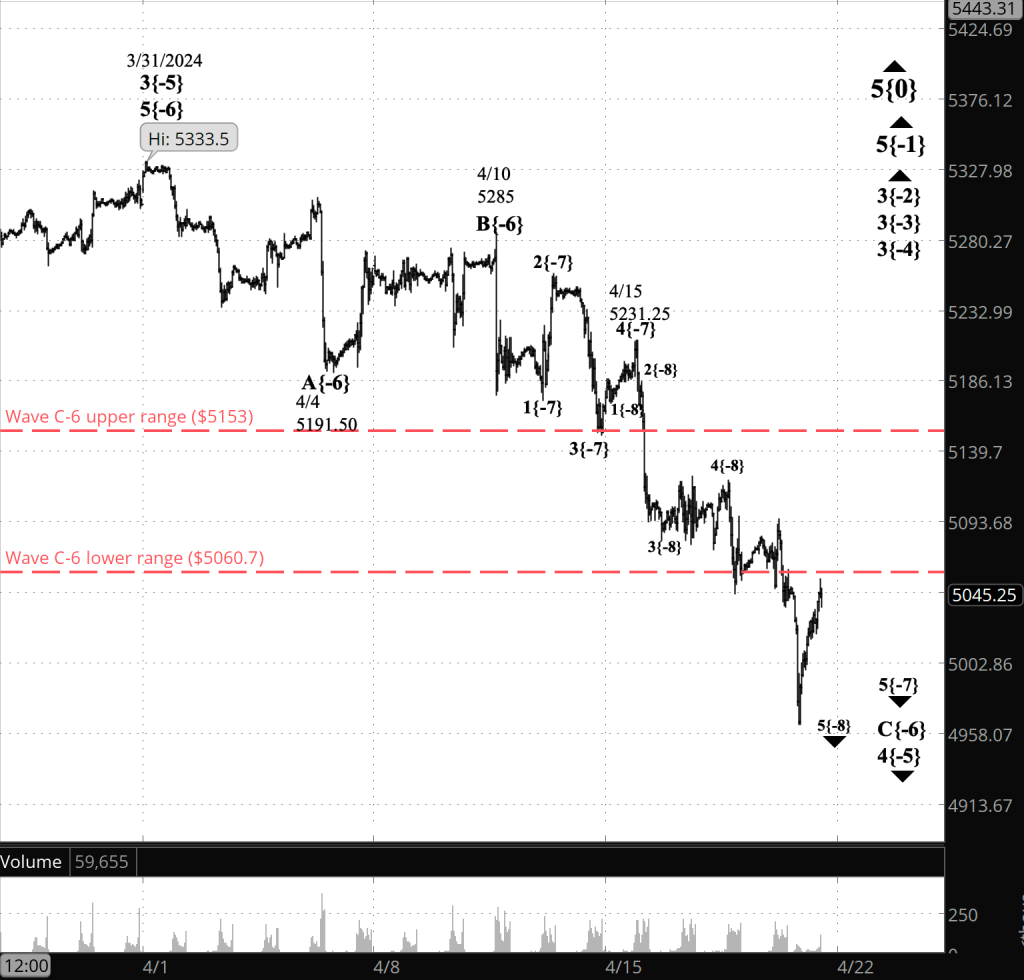3:30 p.m. New York time
Half an hour before the closing bell. The S&P 500 futures drifted lower during the session while remaining above the overnight low, 4963.50. No change in this morning’s conclusions based on Elliott Wave Theory. I’ve updated the chart.
9:35 a.m. New York time
What’s happening now? The S&P 500 E-mini futures rose overnight from the 4960s into the 5050s.
What does it mean? Applying Elliott Wave Theory, I’ve concluded that the decline that began on April 15 is in its next-to-the-last subwave, and one last decline will bring it to an end.
What are the alternatives? The chart can also be interpreted as the mid-April decline having reached its endpoint with the overnight low, 4963.50, and the rise that followed is the beginning of an uptrend. The principal analysis — correction within a downtrend — matches the chart better, in my opinion. Nonetheless, the alternative is a viable possibility.

[S&P 500 E-mini futures at 3:30 p.m., 40-minute bars, with volume]
What does Elliott wave theory say? Here are the waves that underly the analyses, as they appear on the chart. Each wave number is followed by a subscript in curly brackets denoting the wave’s distance from Intermediate degree. The present Intermediate degree wave is 5{0}, and it began in December 2018.
Principal Analysis:
- Rising wave 5{0} is underway. It is a wave of Intermediate Degree that began in December 2018.
- It is in its final subwave, wave 5{-1}
- Within wave 5{-1}, rising waves 3{-2}, 3{-3} and 3{-4} are underway, as is the smallest wave labeled on the chart, wave 4{-5}.
- Downtrending wave 4{-5} is in its final subwave, falling wave C{-6}, which is in its last subwave, falling wave 5{-7}.
- Within wave 5{-7}, wave 5{-8} is underway and is in its next-to-the-last subwave, wave 4{-9}.
Alternative analysis:
- Wave 4{-5}, a downward correction, ended overnight on April 18, along with its subwaves, waves C{-6}, 5{-7}, 5{-8} and 5{-9}.
- Uptrending wave 5{-5} is underway and is in its early stages.
.
We Are Here.
These are the larger waves currently in progress under my principal analysis. Each line on the list shows the wave number, with the subscript in curly brackets, the traditional degree name, the starting date, the starting price of the S&P 500 E-mini futures, and the direction of the wave.
- S&P 500 Index:
- 5{+3} Supercycle, 7/8/1932, 4.40 (up)
- 5{+2} Cycle, 12/9/1974, 60.96 (up)
- 5{+1} Primary, 3/6/2009, 666.79 (up)
- 5{0} Intermediate, 12/26/2018, 2346.58 (up)
Reading the chart. Price movements — waves – – in Elliott wave analysis are labeled with numbers within trending waves and letters with corrective waves. The subscripts — numbers in curly brackets — designate the wave’s degree, which, in Elliott wave analysis, means the relative position of a wave within the larger and smaller structures that make up the chart. R.N. Elliott, who in the 1930s developed the form of analysis that bears his name, viewed the chart as a complex structure of smaller waves nested within larger waves, which in turn are nested within still larger waves. In mathematics it’s called a fractal structure, where at every scale the pattern is similar to the others.
Learning and other resources. Elliott wave analysis provides context, not prophecy. As the 20th century semanticist Alfred Korzybski put it in his book Science and Sanity (1933), “The map is not the territory … The only usefulness of a map depends on similarity of structure between the empirical world and the map.” And I would add, in the ever-changing markets, we can judge that similarity of structure only after the fact.
See the menu page Analytical Methods for a rundown on where to go for information on Elliott wave analysis.
By Tim Bovee, Portland, Oregon, April 19, 2024
Disclaimer
Tim Bovee, Private Trader tracks the analysis and trades of a private trader for his own accounts. Nothing in this blog constitutes a recommendation to buy or sell stocks, options or any other financial instrument. The only purpose of this blog is to provide education and entertainment.
No trader is ever 100 percent successful in his or her trades. Trading in the stock and option markets is risky and uncertain. Each trader must make trading decisions for his or her own account, and take responsibility for the consequences.
All content on Tim Bovee, Private Trader by Timothy K. Bovee is licensed under a Creative Commons Attribution-ShareAlike 4.0 International License.
Based on a work at www.timbovee.com.

You must be logged in to post a comment.